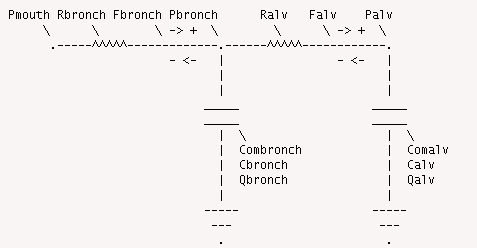Airflow between atmosphere and lung modeled with 2 compartments representing the non-exchanging space (bronchus) and exchanging space (alveolus).
Description
This model represents a simple 2-compartmental respiratory system, consisting of one bronchi compartment and one alveoli compartment. This model is driven by external pressure (Pventil)as with positive pressure ventilation. There is no exchange between the alveoli and blood. The fluid (air) is assumed incompressible. AMOUNT OF MATERIAL IN Vbronch: If Fbronch is positive, the material added is Fbronch*Cair. Note that Fbronch*Cair is positive when Fbronch is positive. If Fbronch is negative, the material subtracted is Fbronch*Cbronch. Note that Fbronch*Cbronch is negative when Fbronch is negative. If Falv is positive, the material being subtracted is -Falv*Cbronch. If Falv is negative, the material being added is -Falv*Calv. AMOUNT OF MATERIAL IN Valv: If Falv is positive, the material being added is Falv*Cbronch. If Falv is negative, the material being subtracted is Falv*Calv. VERIFICATION: The verification test consists in modifying the parameters so that Vbronch is very small, and the solution for Calv corresponds to a solution from the model Lung_RC_Air which has been imported as a data file. See Notes for Figure 4 for complete details.

Equations












where Pmouth is the pressure at the mouth; P scalar multiplies Pventil, a function representing inhalation pressure; Pbronch is the pressure in the bronchi; Palv is the pressure in the alveoli; Pref is the reference pressure; PFRC is the pressure when the alveoli volume is the functional residual capacity; and PVT is the pressure required to inflate the tidal volume in the alveoli. a1 governs the decrease in pressure in the alveoli near the residual volume and a2 governs the increase in pressure in the alveoli near the total lung capacity;
Vbronch is the volume of air in the bronchi; Vbronch0 is the initial volume of air in the bronchi; Valv is the volume of air in the alveoli; VRV is the residual volume; VFRC is the volume of the functional residual capacity; VT is the tidal volume; and VTLC is the total lung capacity.
Qbronch is the amount of material in the bronchi; Qalv is the amount of material in the alveoli; Cair is the concentration of material in the air; Cbronch is the concentration of material in the bronchi; Cbronch0 is the initial concentration of material in the bronchi; Calv is the concentration of material in the alveoli; and Calv0 is the initial concentration of material in the alveoli.
Fbronch is the air flow at the mouth; Falv is the air flow between the bronchi and alveoli; Rbronch is the resistance to the air flow in the bronchi; Ralv is the resistance to the air flow in the alveoli; and Comalv is the compliance of the alveoli.
Amount of Material in Vbronch :
If Fbronch is positive, the material added is Fbronch*Cair. Note that Fbronch*Cair is positive when Fbronch is positive.
If Fbronch is negative, the material subtracted is Fbronch*Cbronch. Note that Fbronch*Cbronch is negative when Fbronch is negative.
If Falv is positive, the material being subtracted is -Falv*Cbronch. If Falv is negative, the material being added is -Falv*Calv .
Amount of Material in Valv:
If Falv is positive, the material being added is Falv*Cbronch. If Falv is negative, the material being subtracted is Falv*Calv .
- Download JSim model MML code (text):
- Download translated SBML version of model (if available):
We welcome comments and feedback for this model. Please use the button below to send comments:
Lutchen, K. R., F. P. Primiano, and G. M. Saidel. A nonlinear model combining pulmonary mechanics and gas concentration dynamics. IEEE Trans. Biomed. Eng. 29: 629-641, 1982. Lutchen KR, Saidel GM, Estimation of mechanical parameters in multicompartment models applied to normal and obstructed lungs during tidal breathing, IEEE Trans. Biomed. Eng., vol. BME-33, no. 9, pp. 878-887, Sept. 1986. M.G. Levitzky, Lange Physiology Series: Pulmonary Physiology, 6th edition. McGraw Hill, 2003.
Please cite https://www.imagwiki.nibib.nih.gov/physiome in any publication for which this software is used and send an email with the citation and, if possible, a PDF file of the paper to:
Or send a copy to:
The National Simulation Resource, Director J. B. Bassingthwaighte, Department of Bioengineering, University of Washington, Seattle WA 98195-5061.
Model development and archiving support at https://www.imagwiki.nibib.nih.gov/physiome provided by the following grants: NIH U01HL122199 Analyzing the Cardiac Power Grid, 09/15/2015 - 05/31/2020, NIH/NIBIB BE08407 Software Integration, JSim and SBW 6/1/09-5/31/13; NIH/NHLBI T15 HL88516-01 Modeling for Heart, Lung and Blood: From Cell to Organ, 4/1/07-3/31/11; NSF BES-0506477 Adaptive Multi-Scale Model Simulation, 8/15/05-7/31/08; NIH/NHLBI R01 HL073598 Core 3: 3D Imaging and Computer Modeling of the Respiratory Tract, 9/1/04-8/31/09; as well as prior support from NIH/NCRR P41 RR01243 Simulation Resource in Circulatory Mass Transport and Exchange, 12/1/1980-11/30/01 and NIH/NIBIB R01 EB001973 JSim: A Simulation Analysis Platform, 3/1/02-2/28/07.

